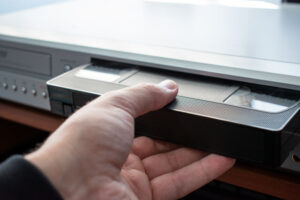
It is good to reflect on the innovations that paved the way for our modern entertainment experiences. Among these ground breaking inventions, the VHS tape stands as a nostalgic icon, capturing the hearts and memories of generations past.
The dawn of VHS tapes can be traced back to the early 1970s, when a consortium of Japanese electronics giants, including JVC (Victor Company of Japan), Sony, and Matsushita Electric (later Panasonic), collaborated to develop a consumer friendly video recording standard. This joint effort initially yielded the U-matic format, released in 1971, which served as a precursor to the VHS we know and love.
However, as the partnership dissolved, each company pursued its own path, leading to the creation of competing formats. Sony introduced the Betamax format in 1975, while Matsushita and JVC focused their efforts on developing the VHS system.
The rise of VHS was not without its challenges. Sony’s Betamax system, introduced a year earlier, initially posed a formidable competitor in the video cassette format war. However, VHS’s longer recording time and lower manufacturing costs ultimately tipped the scales in its favour, solidifying its position as the dominant force in the market.

The release of the Victor HR-3300, the inaugural VHS Video Cassette Recorder (VCR), in 1976, marked a pivotal moment in the history of home entertainment. Suddenly, viewers could not only watch pre-recorded content but also capture and preserve their cherished moments with ease. The RCA VBT200 followed suit as the first VHS VCR introduced to the North American market, further solidifying the format’s dominance.
In the early 1980s, the advent of the first VHS video camera ushered in a new era of personal documentation. Families could now record graduations, weddings, holidays, and other momentous occasions with unprecedented simplicity, thanks to the compact and user-friendly VHS-C (Compact VHS) format.
As the 1980s dawned, VHS tapes gained traction, they swiftly evolved from a technological novelty into a cultural phenomenon. The ability to watch movies, TV shows, and home videos at one’s convenience transformed the way we consumed and interacted with visual media.
The rise of video rental stores, epitomized by the iconic Blockbuster chain, further solidified the VHS format’s dominance. Suddenly, a vast library of titles was at the fingertips of viewers, fostering a new era of movie nights and shared experiences.
People began amassing substantial collections of VHS cassettes, cherishing not only the content but also the physical artifacts themselves. Major movie releases were eagerly anticipated on VHS, and classics from Disney, horror, and action genres found their way into countless households worldwide.
As the popularity of VHS tapes soared, manufacturers continued to refine and enhance the format, introducing improvements that elevated the viewing experience. JVC’s release of the Super VHS (S-VHS) format in the late 1980s brought improved video bandwidth and picture quality, catering to the burgeoning camcorder market.
The introduction of the Super Compact VHS (S-VHS-C) further streamlined the recording process, offering a more compact and portable solution for capturing precious moments on the go.

As with all ground breaking technologies, the reign of VHS tapes was eventually challenged by the advent of digital formats. The introduction of DVDs in the late 1990s ushered in a new era of superior picture and sound quality, interactive menus, and enhanced durability.
The convenience and compactness of DVD players, coupled with the advent of streaming services, gradually eroded the dominance of VHS tapes. The last major motion picture to be released on VHS, “A History of Violence” in 2006, marked the symbolic end of an era, as the industry transitioned towards digital media and on-demand content delivery.
Despite its obsolescence, the cultural impact of VHS tapes remains undeniable. For many, these magnetic reels hold cherished family memories, captured and preserved in a format that was once cutting-edge. As time marches on, the need to digitise and safeguard these priceless moments has become increasingly paramount.
VHS Vault provides media preservation, offering services that convert VHS tapes into digital formats, ensuring that these treasured memories remain accessible and shareable for generations to come.

As we bid farewell to the era of VHS tapes, we do so with a profound sense of gratitude and appreciation for the indelible mark they have left on our collective consciousness. These magnetic marvels were more than mere vessels for entertainment; they were time capsules, preserving our cherished memories and cultural touchstones.
While the digital age has ushered in new and innovative ways to consume media, the legacy of VHS tapes endures. They remind us of the power of shared experiences, the joy of discovery, and the enduring allure of physical media in a world increasingly dominated by the virtual.
So, let us raise a metaphorical toast to the VHS tape, a true pioneer in the realm of home entertainment. Its impact will forever be etched into the annals of history, a testament to human ingenuity and our insatiable desire for storytelling and connection.